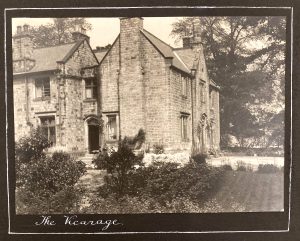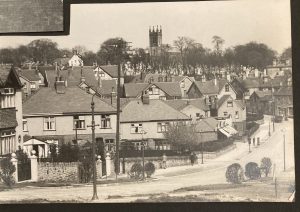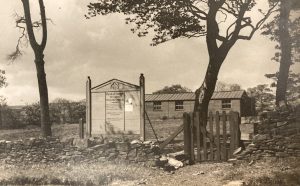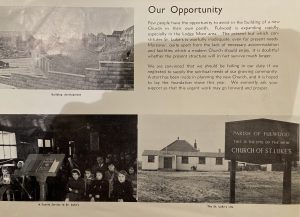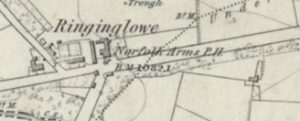Here is Alan Crutch’s piece giving background and context to sport in Fulwood: from Anglo-Saxon period through to the twentieth century.
The earliest organized sporting activity in this area was, almost certainly, hunting. Fulwood was covered in forest and it is likely that the Hall which the Saxon Lord Waltheof owned was what we would identify as a hunting lodge. In the Norman era, Fulwood was part of Rivelin Chase, a large area, set aside for hunting. There was even what we would call a game warden whose job it was to try and prevent the second earliest local sport, namely poaching.
Stopping ordinary people enjoying themselves through sport seems to have been something of an obsession throughout the Middle Ages. Football was certainly a banned activity as it took young men away from what was their civic duty, – archery practice. Back then it was all able-bodied men’s obligation to turn up to hone their skill with the bow. At any time they might be required to go to war as part of the Lord of the Manor’s obligation to provide a certain number of armed men when required by the monarch. In Fulwood they practiced on the May Field. That was the field near the bridge over the stream that supplied the mill built by Ulysses Fox in the 1600’s and which is now the animal sanctuary. The old name for the bridge is Butts Bridge.
The earliest name I have found for a Fulwood man being involved in ‘sporting’ activity is that of John Lynnot. The date was 1441 and he was fined one shilling for playing at rounds and dice and panning. I have no idea what rounds and panning may have been but they were certainly illegal. It seems as though he may have been keeping dubious company because, at the same court, a Robert Le Carre was fined a Mark (a third of a pound) for drawing blood from the same John Lynnot. The Lynnot family probably came over with William the Conqueror and were a well-established Fulwood family holding land in the area of Fullwood Hall and possibly responsible for the original construction of the Hall.
By the time of the Tudors, bowls was a popular game. In Fulwood there was an area off what is now Redmires Road. In his 1637 survey of this area. Harrison describes part of the area now used for the golf course as “Bowling Allie”. Ironically, the area next to it was called Hell Hole and another area is described as “Rough Close”. These are shown on the extract of Scurfield’s plan to the 1637 Harrison survey, all next to Barren Cliffe Highway (now called Redmires Road)
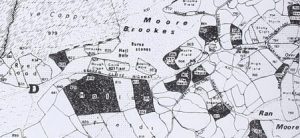
Football still had a bad reputation in the early 1600’s. In King Lear, Shakespeare compares one of the characters to “a base football player ”, and in 1608, a Manchester resident complained
“With the ffotebale … [there] hath beene greate disorder in our towne of Manchester we are told, and glasse windowes broken yearlye and spoyled by a companie of lewd and disordered persons “.
They are like that in Manchester though and I’m sure that Sheffield provided much better players of the game. Notwithstanding this, football, along with all other forms of enjoyment, suffered under the Commonwealth of the 1650’s when the punishment for being caught playing the game was to be put in the stocks (presumably not all at the same time). The stocks in Fulwood were on Brookhouse Green, which was a large Common which included the land on which the Co-op now stands.
Those in the stocks were there for public humiliation, Other forms of punishment were also popular spectator sports. The pillory and the cuckstool (for scolding women) had their own attractions, but far more popular was the gallows. There is a rumour that one existed in the Bennet Grange area, but I have seen no real evidence for this, although there are several reports of hauntings on Harrison Lane near the water troughs.
The market in Sheffield also provided entertainment from time to time. As late as 1822, a hatter auctioned his wife, The winning bidder paid 5 shillings, a silver watch, and a gold chain. R E Leader reports that the original Chronicler reported “The lady it seems was nothing loathe to the transaction.” .
Moving on to more traditional sports and forms of entertainment, these days they often take place on Sunday but in 1732 there was no pie and a pint after a game. This was the message that was sent out to every parish in the land.
“…. The Lords Day is often prophaned in your parish by disorderly Meetings of several idle persons and by Gaming, Sports and Tipling in Publick Houses and Shops and by Persons using their Trades and Callings on that Day contrary to the Laws in that Case made and provided which disorderly and unlawful proceedings, tend to the Encouragement of Vice, Lewdness and Immorality, to the great dishonour of GOD, Disturbance of the Inhabitants, and evil Example to others.”
Despite restrictions like the above, the Commons and Village Greens in Fulwood were areas used for recreation, Some of the games played there would have been familiar to us. Skittles, Quoits, Knurr and Spell and Penny Prick were all played. Penny Prick was a game where oblong pieces of iron were thrown at a mark some distance away.
I had heard of Knurr and Spell but did not know much about it until I did some research. It seems to have been very popular in Yorkshire and originated on the Yorkshire Moors. The Knurr was a small round ball of wood or porcelain about the size of a walnut and the Spell was a lever that released the Knurr into the air where it would be hit with a four-foot long wooden stick often made of ash to which was attached a six inch long by four inch wide pommel made of very hard wood. The Knurr might travel up to 200 yards once struck. Not a bad drive even by today’s standards.
Less acceptable today were the bull baiting, dog fighting, cock fighting and bare-knuckle prize fights that took place. The nearest evidence of cock fighting taking place in the Fulwood region is again given by Harrison in his 1637 survey. On the map prepared by Scurfield, the area we now know as Ranmoor was described as Cockpitt Green! As Leader observed in 1901,
As villages and towns and counties now compete with one another at cricket and football, so in those days the championship they aspired to was to breed cocks that could kill those of the rival community.”
Below shows Cockpitt Green to the far right of the extract. I wonder how popular it would be if Ranmoor was to revert to its old name? As can be seen, Fulwood Road did not exist in 1637.
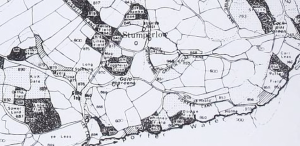
Similar to cock-fighting, there was one other activity that the authorities were concerned about – Throwing at Cocks. This was a barbaric practice which involved object being thrown at a live cockerel with the sole intention of injuring and eventually killing the bird. It was decided that the public should be encouraged to enjoy more wholesome entertainment, and so the Sheffield Town Trustees attempted to divert the population away from that spectacle in 1757 by paying cricket players 14s 6d to play a match in Sheffield on Shrove Tuesday to “entertain the populace and prevent the infamous practice”. So by the 1750’s the authorities were beginning to change their attitude to organized sport.
Then there was horseracing. This plan shows the famous one superimposed on a modern map
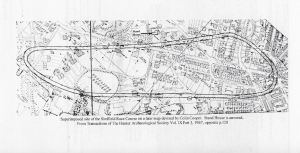
Horseracing was popular with all classes. The course existed between 1713 and 1785 but was swept away by enclosure (its removal was partly responsible for a subsequent riot in Sheffield). Lesser known was our own Fulwood Racecourse, technically at Redmires, but we are still claiming it as ours. Keith Baker’s book Redmires Tales from the Ridge tells the story that, in the 1870’s a group mostly comprising local publicans decided that horse-racing needed to return to Sheffield. Redmires was the chosen site, no doubt much to the pleasure of the landlords of the Three Merry Lads and the Sportsman Inns which were immediately next to the course, a one-hundred-acre site situated between Redmires Road and Brown Hills Lane which was one of the few places in the Sheffield area that was reasonably flat! I am told that for two years prior to completion of the project, greyhound racing took place on the site.
Opening day was Monday 30th August 1875 and the Redmires Road was thronged with people and carriages hours before the first race which was scheduled to start at 14.30. Commenting on how full the local ale houses were on that day, a local reporter wrote
“It was a question for wonderment that so many people should be so thirsty at the same time, and that so many others have the overpowering idea of the value of getting drunk before the racing began ……”
To get into the course the drinkers and all others would have had to pay sixpence. Entry to the grandstand cost five shillings. There were five races and various forms of entertainment. The meeting was well attended and a financial success. The following day the meeting was less well attended, presumably because most of the would-be spectators had lost what money they had on the previous day! There was only ever one further meeting before the whole enterprise failed. A few high walls that use to surround the course can still be found, but Fulwood’s Ascot is now long gone.
More recently (1973) Charles Marsden recorded his memories of children’s games in Fulwood. These are his recorded words
We used to play at different games that they don’t know nowt about now. Peggy for one thing.
We get a broom shaft, saw it about that length [ten inches] and sharpen it at both ends. Then ‘ave a part of broomshaft to tap it with you. You used to tap it then strike at it or otherwise tap it and double with it, hit twice. You had to stride, give ’em how many you thought they could do it in. If you thought they could do it in twelve you might — we used to start off at Greenfall Gate here — you’d gi’ ’em ten, well they had to try but they couldn’t do it. That counted to you. That’s ten to you.
Then we used to play at Kickcan a lot, Whip we called it. We had old can, top of yard yonder ••• See who were goin’ to be on, you know, who were last out. Him that were on were to kick ‘is can as far as he could and he’d to go for it, and while he were going for it, we were playing Hidey. If he went far away from can to seek us out, somebody come out from somewhere else and kicked it again. Then he had to find you all .
Soon as we got out of school, ‘Stop in last un at Blackthorn’ , that were a decent job. Used to have a mark across road down by’t school ‘ere and as far as Greenfall Gate. ‘Im ‘at were last in ‘ad to be in for a start. ‘E’d to be in t’middle between lines like, well, they could try to get past him. They’d be one goin’ past one way and one goin’ past other. Most of ’em ‘ad got their jacket sleeves torn off. When you caught one he’d to stop in and help you.
We played at Rusty a lot you know. One stood at wall for your pillow and if there were three on you playing three more, three on you got down, got with your head down on to ‘im and t.’other got ‘old of your jacket back. These other three used to have to jump on you and used to land on back of you, no scrawming, you used to be trying to scrawm up. But if one fell off you see they lost. ~’hoy’ d to got down. You had to. hold ’em while you gave in like. I know I were very of ton first to jump and I’d only one good leg but I could ‘op .;I. ~ong way. I could ‘op onto third man many a time, plenty of room for other two to come. It were Rusty an’ all one lad got’s leg broke wi’t at side of Royal.
We’d talk about playing In and In, same as Kickcan nearly. You’d to be in den, side of gate an’ they’d to go out and get Hidey like and you’d to go and find them. We used to go round top of street, there were some old places, a blacksmith’s shop and two or three more places you could go. It’s a long way downt’ Street and I’ve had my knees peeled many a time. Used to be a rum road. Daren’t go and find you.
Then we had sometimes, ‘it were like a hunt. They used to go right round Hill Top, all the way round. You had to go after them like hare hunting. Hare an’ Hounds, no trail. You had to shout, ‘Give a Tally O~’ so they’d ‘Hoo-hoo~’. You had an idea which way they was. They happen weren’t there when you got there, you know.
Recorded 12 July 1973.
